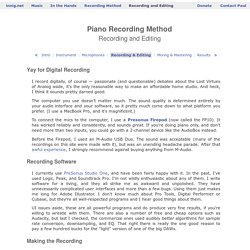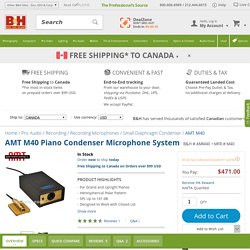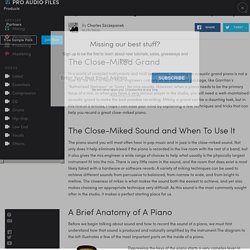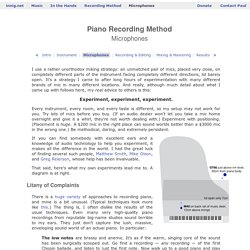

Five Adobe Audition CC Effects To Better Quality Voice Overs. How To: Remove Static / Background Noise in Adobe Audition. How to: Make Your Voice Sound Better Like Studio Quality in Adobe Audition. Paul Cantrell's piano recording method: Recording and Editing. Piano Recording Method Recording and Editing Yay for Digital Recording I record digitally, of course — passionate (and questionable) debates about the Lost Virtues of Analog aside, it's the only reasonable way to make an affordable home studio.

And heck, I think it sounds pretty darned good. The computer you use doesn’t matter much. To connect the mics to the computer, I use a Presonus Firepod (now called the FP10). Before the Firepod, I used an M-Audio USB Duo. Recording Software I currently use PreSonus Studio One, and have been fairly happy with it. UI issues aside, these are all powerful programs and do produce very fine results, if you're willing to wrestle with them. Making the Recording I record at 96 kHz, 24 bits.
I'm extremely meticulous about placing the mics in exactly the same location every time I record. The one thing I do have to adjust every time I record is the input level — some pieces are louder than others! Then comes the music. Cleaning Up Unwanted crap still sneaks in. GROOVE TUBES GT55 FET LARGE DIAPHRAGM CONDENSER GT55 MICROPHONES. FREE SHIPPING. Rode NTK Tube Condenser Microphone: Musical Instruments. AMT M40 Piano Condenser Microphone System M40 B&H Photo Video. The M40 Condenser Microphone by AMT is designed to be set inside a grand or upright piano to capture live performances with a natural and even sound.

While geared for sound reinforcement, it works equally well in the recording studio or as a boundary mic for a conference or a stage. The microphone is intended to be placed between the 2nd and 3rd sound holes on the cast-iron plate of a grand piano or fastened to the front bottom door of an upright piano. It delivers an accurate sound with a flat frequency response (20 Hz to 20 KHz) and can handle SPL up to 141 dB to capture subtle passages or thunderous fortissimos. The mono design precludes the introduction of phase issues often associated with multiple microphones, and ensures that the individual sound characteristics of each particular piano remain uncompromised.
This compact and lightweight microphone allows for a wide range of placement options. Top 5 Unusual Recording Tips & Techniques You Should Try. 1) BINAURAL RECORDING (as used by: Lou Reed in Street Hassle, Take No Prisoners and The Bells) Binaural recording is a method of recording sound that uses two microphones, arranged with the intent to create a 3-D stereo sound sensation for the listener of actually being in the room with the performers or instruments.

The results can surprise you, giving a more naturalistic feel to your sound. Lou Reed used the technique on a trio of albums in the late seventies, including Take No Prisoners, considered by some one of the best-sounding live albums ever, as it really puts you in the middle of the audience. To achieve a realistic binaural sound is not very straightforward, hence the fact this technique is not too popular. You could try to mimic it with two microphones placed 18 cm (7") apart facing away from each other, but this method will not create a real binaural recording. A more affordable option is the Roland CS-10EM Binaural Stereo Microphones & Headphones. 5) IF EVERYTHING FAILS...
Tips for Recording an Acoustic Piano (Part I) — The Pro Audio Files. The Close-Miked Grand In a world of sampled instruments and midi sequencing, recording an acoustic grand piano is not a task for the faint of heart.

Most engineers can rely on an instrument package, like Garritan’s “Authorized Steinway” or “Ivory”, for nice sounds. However, when a piano needs to be the primary focus of a mix, or when you have a very serious player in the studio, you will need a well-maintained acoustic grand to make the best possible recording. Miking a grand can be a daunting task, but in this first of 3 articles, I hope I can ease your mind by explaining a few techniques and tricks that can help you record a great close-miked piano. Paul Cantrell's piano recording method: Microphones.
Piano Recording Method Microphones I use a rather unorthodox miking strategy: an unmatched pair of mics, placed very close, on completely different parts of the instrument facing completely different directions, lid barely open.

It's a strategy I came to after long hours of experimentation with many different brands of mic in many different locations. And really, although much detail about what I came up with follows here, my real advice to others is this: Experiment, experiment, experiment. Every instrument, every room, and every taste is different, so my setup may not work for you.
If you can find somebody with excellent ears and a knowledge of audio technology to help you experiment, it makes all the difference in the world. That said, here's what my own experiments lead me to. Litany of Complaints There is a huge variety of approaches to recording piano, and mine is a bit unusual. The low notes are brassy and anemic.